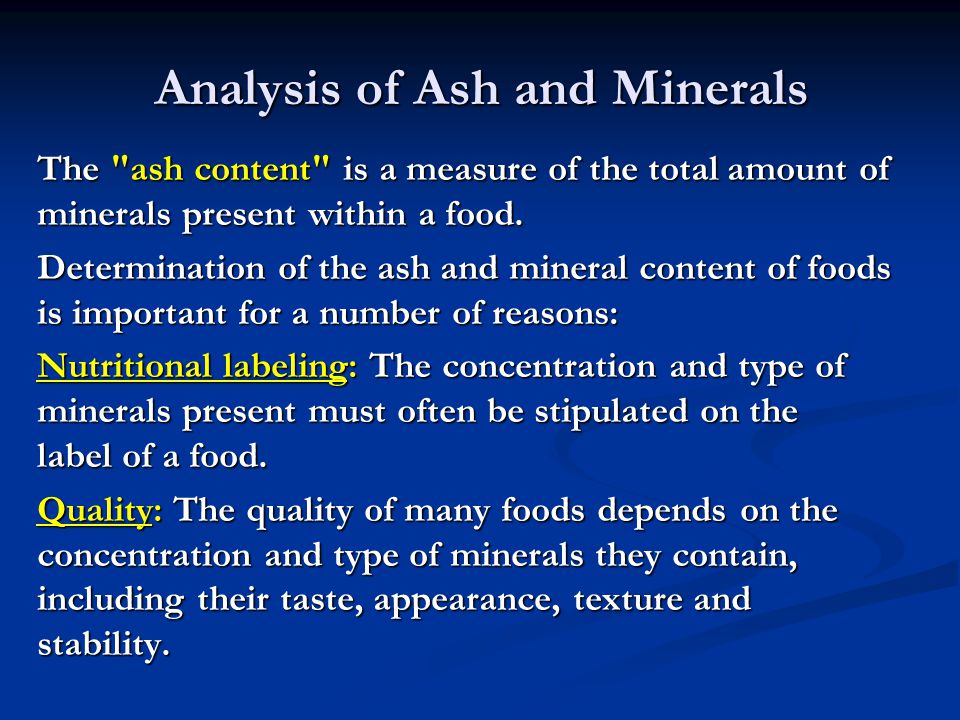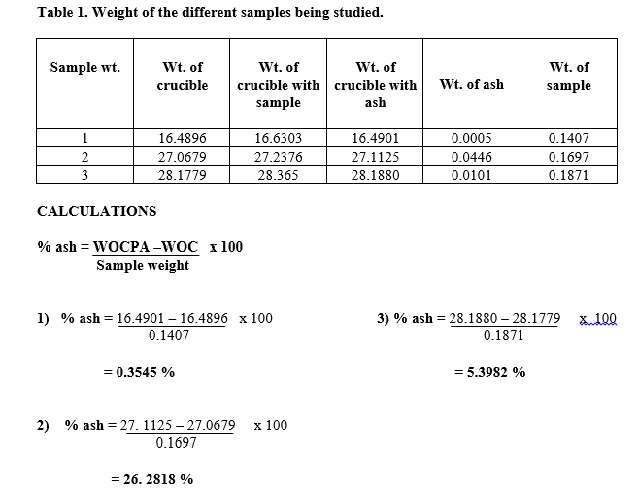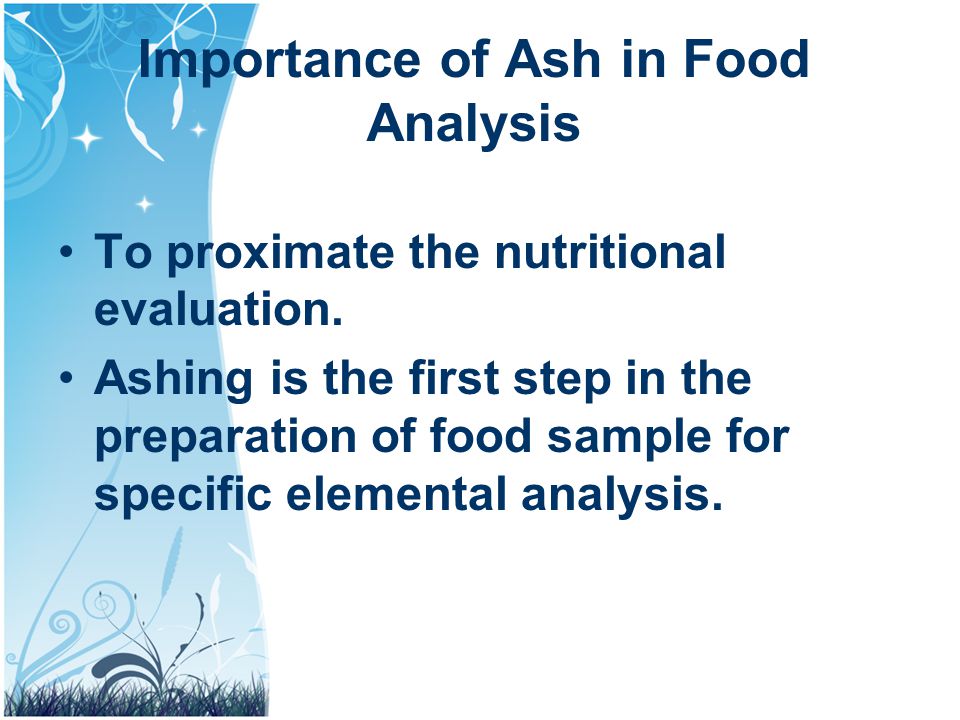ash content in food determination
Department of Agricultures nutrient database can easily show you the. Seven samples of various food commodities with estimated ash contents varying between low and high 007-80 g100 g were included in the study.

Food Analysis 473 Phg Ppt Video Online Download
Also ashing is the first step in the preparation of a sample for specific.

. Where MASH Mass of the ash sample. And absorption has been used in the determination. It is a part of proximate analysis for nutritional evaluation.
Typically the ash value is in the range of 003 007 by weight although in certain oils higher ash content may be found. Ash consists of extraneous solids residues of organometallic compounds in solution and salts dissolved in water present in the fuel. It is a routine test with renewed interest due to the incorporation of ash values into modern equations for the estimation of energy content of dairy feed beef feed and pet food.
Its called ash because its. What Is Ash in Food. Wet Ashing This technique of determining ash content in a food sample is comparatively faster than other techniques.
Ash refers to the inorganic residue remaining after either ignition or complete oxidation of organic matter in a food sample. It represents a part of quality of a sample. The following result were obtained.
The ash content is ex pressed as a percentage of the mass of the. Determination of the ash and mineral content of foods is important for a number of reasons. The ash content is a measure of the total amount of minerals present within a food whereas the mineral content is a measure of the amount of specific inorganic components present within a food such as Ca Na K and Cl.
The time period may range from 10 minutes to few hours. Methods for ash determination in meat and meat products are generally based on the drying and charring of the sample followed by its combustion until white or light grey ashes are obtained. Ashing is the first step in preparing a food sample for specific elemental analysis.
In heating we assume that at 700oC all other hydrocarbons are burned off. Peppers give a light gi eenish-blue ash which is due to the presence of copper. The ash content is a measure of the total amount of minerals present within a food whereas the mineral content is a measure of the amount of specific inorganic components present within a food such as Ca Na K and Cl.
In this process the temperature range is set at 350C. AOAc Official Method SM 94205 Ash in Animal Feed has been applied in feed laboratories since its publication in the Official Methods of Analysis in 1942. The analysis of ash content in foods is simply the burning away of organic content leaving inorganic minerals.
As with other empirical methods results obtained are a function of the test conditions. This helps determine the amount and type of minerals in food. The difference in weight before and after the test is the percentage of ash content.
Ash content represents the total mineral content in foods. It is a routine test with renewed interest due to the incorporation of ash values into modern equations for the estimation of energy content of dairy feed beef feed and pet food. Weigh about 3-5 g of sample to paper filter and wrap.
There are differences though amongst the various recommended methods as to charring procedure ashing temperature and whether or not to add reagents in order to hasten the. Determination of Ash is one of the important proximate analysis for food feed vegetable and many other samples. Spanish saffron yields a white or very pale gray ash.
Determination of the ash and mineral content of foods is important for a number of reasons. Moisture content 1192-1325 ash content 084-128 crude fat 020-058 crude protein 450-631 crude fibre 040-072 carbohydrate 7871-81. Determining the ash content may be important for several reasons.
Determining the ash content of a food is part of proximate analysis for nutritional evaluation and it is an important quality attribute for some food ingredients. The presence of Ash in crude oil is unfavorable because it can cause corrosion during crude oil treatment. AOAC Official Method 94205 Ash in Animal Feed has been applied in feed laboratories since its publication in the Official Methods of Analysis in 1942.
The ISO method gave significantly higher results than the other methods tested. 23 Methods C and D Ash content of a peat or organic soil sample is determined by igniting the oven-dried sample from the moisture content determination in a muffle furnace at 440C Method C or 750C Method D. Various procedures for determining ash content of meat products have been compared.
The determination of ash content can be carried out using a furnace whereby the crude samples are combusted up to 700oC. Cinna- mon ash is white or nearly so and that of cassia is brown or brownish gray. The standard method IAS 2-043 gave lower recoveries and in one of the experiments lower results for ash content than the other methods tested.
Methods for moisture determination in food products. As with other empirical. The substance remaining after ignition is the ash.
American saffron or safflower has a red-brown ash. Determining the ash content of a food is part of proximate analysis for nutritional evaluation and it is an important quality attribute for some food ingredients. Food item Ash content 01 Most fresh foods 5 02 Pure oils and fats No ash 03 Dairy products 05-51 04 Dried fruits 24-35 05 Flours and meals 02-06 06 Pure starch 03 07 Wheat germ 43 08 Nuts and nut products 08-34 09 Meat poultry and sea foods 07-13 5.
Ash content is a widely accepted index of refinement of foods such as wheat flour or sugar. Because certain foods are high in particular minerals ash content becomes important. Important because the amount of minerals can determine physiochemical properties of foods as well as retard the growth of microorganisms.
Ash refers to any inorganic material such as minerals present in food. While sources such as the US. For this method the critical conditions are the ignition time ignition temperature and any other furnace or.
Ash Content in foods Sr. Analysis of Ash Contents of Foods 35. Clove ash is dark green while most other kinds are white or gray.
Ashing is also the first step in preparing a sample for particular elemental analysis Ismail 2017. The food is ashed at 550 degrees C to constant weight and the ash is determined by weighing.
.jpg)
How To Analyse Ash Content In Food Products

Experiment 2 Analysis Of Ash Forever Hungry

Lecture 4 Ash Analysis Ppt Video Online Download

Lecture 4 Ash Analysis Ppt Video Online Download
Proximate Analysis In Food Samples

Lecture 4 Ash Analysis Ppt Video Online Download



Komentar
Posting Komentar